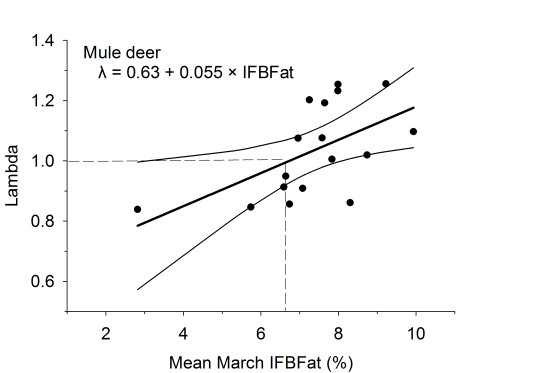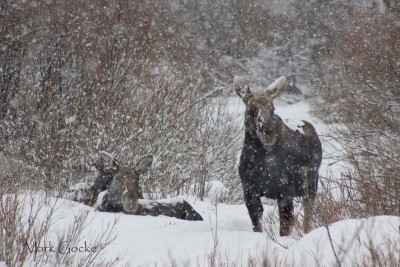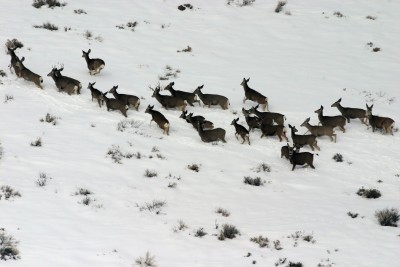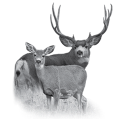About our work

Our research focuses on integrating nutritional ecology with intensive field studies to understand to elucidate the mechanisms that underpin behavior, growth, reproductive allocation, predator-prey dynamics, and ultimately, the factors regulating population growth. We strive to keep our work grounded within a strong conceptual framework that builds on ecological theory, and importantly, informs on-the-ground management efforts. Ultimately, pressing conservation questions often form the initial line of inquiry as our work aims to help develop the tools and provide the empirical information necessary to equip resource managers with the power to make informed decisions. Although our approach varies according to study needs, we often employ fairly intensive field studies with longitudinal monitoring of life history and nutritional status of individual animals. Indeed, we find the lens of nutrition to be the most revealing ecological indicator to understand fitness and population ecology for these long-lived mammals.
Developing tools for habitat-based, sustainable management of ungulates

A centerpiece for much of the applied components of our work is focused on development and implementation of tools for sustainable management of ungulates, with a specific eye towards identifying factors regulating populations. To do so, one must understand the proximity of a population to nutritional carrying capacity—a classic question in wildlife ecology and one that the wildlife field has struggled to make significant progress in for over a century despite pioneers of the field (e.g., Aldo Leopold, Paul Errington) calling attention to this matter in the 1930s and 40s. Our research in this arena integrates measures of nutritional condition and population performance to estimate the proximity of a population to animal-indicated nutritional carrying capacity. In essence, when food resources are abundant (i.e., population well below nutritional carrying capacity), populations have the potential to grow rapidly in size until density-dependent feedback heightens, competition for resources increase, nutritional condition declines, and productivity and population growth subsides. Although knowledge of nutritional carrying capacity is of utmost importance for empirically and habitat-based management, efforts to elucidate factors regulating populations provide a foundation for further investigations (most of those outlined in the following) to ask more complex questions. For example, understanding predator-prey dynamics is contingent upon first understanding the ability of available habitat to support the prey population, especially for strongly density-dependence species.
Related Projects:
Effects of Human Disturbance on the Nutritional Ecology of Mule Deer
Disentangling the Effect of Predation, Nutrition, and Habitat on Survival of Neonatal Mule Deer
Nutritional Dynamics and Interactions with Disease in Bighorn Sheep
Demographics and Nutritional Response of Moose to Beetle Kill in the Snowy Range
Deer-Elk Ecology Research Project
Related Publications:
Bowyer, R. T., V. C. Bleich, K. M. Stewart, J. C. Whiting, and K. L. Monteith. 2014. Density dependence in ungulates: a review of causes, and concepts with some clarifications. California Fish and Game 100:550–572.
Monteith, K. L., V. C. Bleich, T. R. Stephenson, B. M. Pierce, M. M. Conner, J. G. Kie, and R. T. Bowyer. 2014. Life-history characteristics of mule deer: effects of nutrition in a variable environment. Wildlife Monographs 186:1–62.
Bowyer, R. T., J. G. Kie, D. K. Person, and K. L. Monteith. 2013. Metrics of predation: perils of predator-prey ratios. Acta Theriologica 58:329-340.
Pierce, B. M., V. C. Bleich, K. L. Monteith, and R. T. Bowyer. 2012. Top-down versus bottom-up forcing: evidence from mountain lions and mule deer. Journal of Mammalogy 93:977–988.
Shallow, J. R. T., M. A. Hurley, K. L. Monteith, and R. T. Bowyer. 2015. Cascading effects of habitat on maternal condition and life-history characteristics of neonatal mule deer. Journal of Mammalogy 96:194–205.
Large herbivores and a changing environment
 Multiple aspects of the environment in which large herbivores reside have been and continue to be altered dramatically, thereby reinforcing the need to understand how individuals respond to and cope with their changing world. The effects of energy development and the ensuing habitat fragmentation and anthropogenic disturbance remain a contentious issue, and an ever-increasing question faced by wildlife researchers. Meanwhile, the epidemic caused by the mountain pine beetle has transformed much of the pine forests throughout the West, and changing climate and drought conditions continue to modify landscapes but in more subtle ways; the consequences of which remain unclear for maintenance of important game species. Behavioral avoidance of areas with high disturbance has been an emerging conclusion for large ungulates, and suggests they perceive this disturbance as a source of risk. The pine-beetle transformation may both influence how animals use the landscape and shift the value of components of the landscape, thereby creating new, unforeseen tradeoffs. Although climate patterns in the most recent decade have resulted in milder winters (historically our focus in ungulate ecology), those patterns have in turn resulted in hotter and drier summers, with abbreviated springs. Consequently, the apparent benefits of milder winters may well be negated by poorer forage production during summer. Our work herein seeks to understand how large herbivores respond to changes in habitat structure and function, seeks to explain the heterogeneity in response among individual animals, and determine what the fitness consequences are of those changes.
Multiple aspects of the environment in which large herbivores reside have been and continue to be altered dramatically, thereby reinforcing the need to understand how individuals respond to and cope with their changing world. The effects of energy development and the ensuing habitat fragmentation and anthropogenic disturbance remain a contentious issue, and an ever-increasing question faced by wildlife researchers. Meanwhile, the epidemic caused by the mountain pine beetle has transformed much of the pine forests throughout the West, and changing climate and drought conditions continue to modify landscapes but in more subtle ways; the consequences of which remain unclear for maintenance of important game species. Behavioral avoidance of areas with high disturbance has been an emerging conclusion for large ungulates, and suggests they perceive this disturbance as a source of risk. The pine-beetle transformation may both influence how animals use the landscape and shift the value of components of the landscape, thereby creating new, unforeseen tradeoffs. Although climate patterns in the most recent decade have resulted in milder winters (historically our focus in ungulate ecology), those patterns have in turn resulted in hotter and drier summers, with abbreviated springs. Consequently, the apparent benefits of milder winters may well be negated by poorer forage production during summer. Our work herein seeks to understand how large herbivores respond to changes in habitat structure and function, seeks to explain the heterogeneity in response among individual animals, and determine what the fitness consequences are of those changes.
Related Projects:
Effects of Human Disturbance on the Nutritional Ecology of Mule Deer
Influence of Beetle Kill on Elk and Hunter Resource Selection and Interactions
Demographics and Nutritional Response of Moose to Beetle Kill in the Snowy Range
Related Publications:
Lendrum, P. E., C. R. Anderson, K. L. Monteith, J. A. Jenks, and R. T. Bowyer. 2013. Migrating mule deer: effects of anthropogenically altered landscapes. PloS ONE:e64548.
Copeland, H. E., H. Sawyer, K. L. Monteith, D. E. Naugle, A. Pocewicz, N. Graf, and M. J. Kauffman. 2014. Conserving migratory mule deer through the umbrella of sage-grouse. Ecosphere 5:art117.
Long, R. A., R. T. Bowyer, W. P. Porter, P. Mathewson, K. L. Monteith, and J. G. Kie. 2014. Behavior and nutritional condition buffer a large-bodied endotherm against the direct and indirect costs of climate. Ecological Monographs 84:513–532.
Monteith, K. L., V. C. Bleich, T. R. Stephenson, B. M. Pierce, M. M. Conner, J. G. Kie, and R. T. Bowyer. 2014. Life-history characteristics of mule deer: effects of nutrition in a variable environment. Wildlife Monographs 186:1–62.
Monteith, K. L., R. W. Klaver, K. R. Hersey, A. A. Holland, T. P. Thomas, and M. J. Kauffman. 2015. Effects of climate and plant phenology on recruitment of moose at the southern extent of their range. Oecologia 178:1137–1148.
The ecology of migration
 In terrestrial ecosystems, there is critical need to understand the influence of climate change on the spatial and temporal heterogeneity in forage conditions (i.e., quantity and quality) and the wildlife species that depend on it. In response to seasonal changes in plant growth and phenology, and local climatic conditions, temperate ungulates commonly migrate between high-elevation summer ranges and low-elevation winter ranges. Although ecologists have proposed that migrants follow plant phenology along their migration routes, the mechanisms of long-distance migration and their presumed benefits have yet to be empirically validated, and how climate change may alter the benefits of this behavioral strategy remain unclear.
In terrestrial ecosystems, there is critical need to understand the influence of climate change on the spatial and temporal heterogeneity in forage conditions (i.e., quantity and quality) and the wildlife species that depend on it. In response to seasonal changes in plant growth and phenology, and local climatic conditions, temperate ungulates commonly migrate between high-elevation summer ranges and low-elevation winter ranges. Although ecologists have proposed that migrants follow plant phenology along their migration routes, the mechanisms of long-distance migration and their presumed benefits have yet to be empirically validated, and how climate change may alter the benefits of this behavioral strategy remain unclear.
Related Projects:
Phenology Tracking by Migratory Mule Deer
Disentangling the Effect of Predation, Nutrition, and Habitat on Survival of Neonatal Mule Deer
Deer-Elk Ecology Research Project
Related Publications:
Jones, J. D., M. J. Kauffman, K. L. Monteith, B. M. Scurlock, S. E. Albeke, and P. C. Cross. 2014. Winter feeding alters migration of elk in western Wyoming. Ecological Applications 24:1769–1779.
Lendrum, P. E., C. R. Anderson, K. L. Monteith, J. A. Jenks, and R. T. Bowyer. 2014. Movement of a rapidly migrating ungulate: effects of forage quality. Mammalian Biology 79:369–375.
Monteith, K. L., V. C. Bleich, T. R. Stephenson, B. M. Pierce, M. M. Conner, J. G. Kie, and R. T. Bowyer. 2014. Life-history characteristics of mule deer: effects of nutrition in a variable environment. Wildlife Monographs 186:1–62.
Monteith, K. L., V. C. Bleich, T. R. Stephenson, B. M. Pierce, M. M. Conner, R. W. Klaver, and R. T. Bowyer. 2011. Timing of seasonal migration in mule deer: effects of climate, plant phenology, and life-history characteristics. Ecosphere 2:art47.
Resource allocation and state-dependence
 We have long assumed that in seasonal environments, large herbivores undergo a resource bottleneck during winter that leads to catabolism of body reserves (i.e., both fat and protein) to meet costs of maintenance. To do so, it was thought that individuals reduce their energetic costs to conserve what body reserves they had, and that mortality was an inevitable outcome of entering winter in poor condition. Counter to that notion, however, we have shown that individuals regulate their body reserves in largely a state-dependent manner. Consequently, an individual’s nutritional state may not only affect how it regulates body reserves, but we expect also might have a cascading effect on other life functions, such as behavioral processes, allocation of resources to reproduction, investment in immune response and tolerance of infection, and sensitivity to disturbance or competition. Work in this line of reasoning spans multiple disciplines, but the common thread seeks to explain individual heterogeneity in response to environmental stressors, whether natural or anthropogenic.
We have long assumed that in seasonal environments, large herbivores undergo a resource bottleneck during winter that leads to catabolism of body reserves (i.e., both fat and protein) to meet costs of maintenance. To do so, it was thought that individuals reduce their energetic costs to conserve what body reserves they had, and that mortality was an inevitable outcome of entering winter in poor condition. Counter to that notion, however, we have shown that individuals regulate their body reserves in largely a state-dependent manner. Consequently, an individual’s nutritional state may not only affect how it regulates body reserves, but we expect also might have a cascading effect on other life functions, such as behavioral processes, allocation of resources to reproduction, investment in immune response and tolerance of infection, and sensitivity to disturbance or competition. Work in this line of reasoning spans multiple disciplines, but the common thread seeks to explain individual heterogeneity in response to environmental stressors, whether natural or anthropogenic.
Related Projects:
Effects of Human Disturbance on the Nutritional Ecology of Mule Deer
Nutritional Dynamics and Interactions with Disease in Bighorn Sheep
Phenology Tracking by Migratory Mule Deer
Deer-Elk Ecology Research Project
Related Publications:
Jones, J. D., M. J. Kauffman, K. L. Monteith, B. M. Scurlock, S. E. Albeke, and P. C. Cross. 2014. Winter feeding alters migration of elk in western Wyoming. Ecological Applications 24:1769–1779.
Long, R. A., R. T. Bowyer, W. P. Porter, P. Mathewson, K. L. Monteith, and J. G. Kie. 2014. Behavior and nutritional condition buffer a large-bodied endotherm against the direct and indirect costs of climate. Ecological Monographs 84:513–532.
Monteith, K. B., K. L. Monteith, L. E. Schmitz, R. T. Bowyer, D. M. Leslie, Jr., and J. A. Jenks. 2014. Reproductive and sex-specific effects on the reliability of fecal nitrogen as an index of diet quality. Journal of Mammalogy 95:301–310.
Monteith, K. L., T. R. Stephenson, V. C. Bleich, M. M. Conner, B. M. Pierce, and R. T. Bowyer. 2013. Risk-sensitive allocation in seasonal dynamics of fat and protein reserves in a long-lived mammal. Journal of Animal Ecology 82:377–388.
Monteith, K. L., V. C. Bleich, T. R. Stephenson, B. M. Pierce, M. M. Conner, R. W. Klaver, and R. T. Bowyer. 2011. Timing of seasonal migration in mule deer: effects of climate, plant phenology, and life-history characteristics. Ecosphere 2:art47.


